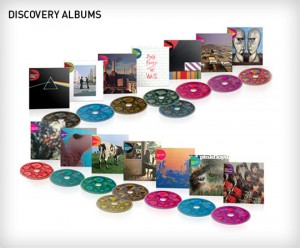
As a music lover for over two thirds of my life (I can’t, in all honesty, include the first ten years, although I did grow up listening to my mother’s well-loved copy of Rubber Soul) and a fan of progressive music in general, the question “why Pink Floyd” is axiomatic – Pink Floyd, quite simply, are one of the greatest rock bands to have existed. To their detractors they are seen as overblown, pompous, divisive and even worse but, to their legions of fans across the globe, they are a band to whom we return time and time again. EMI know this and, as a result, the Pink Floyd back catalogue has been repackaged and recreated more times than almost any other back catalogue in history – particularly if you look at the repressing of the most popular releases.
Thus in 2011, the “why Pink Floyd?” campaign vexed fans of the band by issuing entirely new re-masters for every studio album the band released, along with Experience and Immersion editions of ‘the big three’ . The resultant racket on the internet has centred around two main threads – the first concerning the packaging/rip-off/money-grabbing aspect and the second concerning the actual benefits of the re-masters themselves. This review – looking at the Discovery box set will attempt to resolve some of these issues. It will not, however, review the albums themselves for that is ground sufficiently well-trodden enough at this point.
As stated at the outset, I have been an avid fan of Pink Floyd for many years. My first encounter with the band was at school. I was fascinated, initially, by the covers – they were unlike any other album I’d seen and, as all good covers should, they encouraged me to check out some of the music within. I started with The Wall and immediately found myself lost within the album for weeks, thrilled by the snarling Another Brick In The Wall (Part 2), elated by the high drama of The Trial and then, of course, there was Comfortably Numb, a song that ranks in my top ten songs of all time and which never fails to bring goose-bumps to my arms whenever I hear it.
Subsequently I collected the entire back catalogue, to which end, I own the mid-90s re-masters as well as various original vinyl pressings. To date, I must confess to finding the vinyl best for sonic quality, pops and crackles notwithstanding and the reason for this is simply that the mid-90s re-masters often felt flat, with certain subtle elements missing entirely. Try, for example, listening to Wish You Were Here on CD and then the original vinyl pressing and you’ll see what I mean. The spacey effects at the start of Shine On… are all but entirely absent from the re-master, whilst the resonating bass of Welcome To The Machine has none of the savagery of the vinyl pressing, even at high volumes. Equally the re-master of Animals failed entirely to match up to the high hopes set by the original vinyl pressing and, as many have noted over the years, the drum sound on that version is truly poor. Now, in truth, there is only so much that can be done by re-mastering an album as opposed to going for an all-out remix in the manner of the King Crimson back catalogue, and the 90s re-masters certainly did improve over the original CD pressings, but to many they felt far from definitive.
Enter, then, the 2011 re-masters which are, for the most part, an improvement on the previous set; and certainly the discovery box set itself is a great improvement, sonically, over the confused mishmash that was Oh By The Way which didn’t seem to know which versions to go for and thus offered representatives from across the board ( please note, before you overload my message board with vitriol, that I mentioned it was ‘sonically’ an improvement and not materially – we’ll come to that later).
So in what ways do the new versions improve upon what has gone before? Well, this is where the debate becomes intense and your opinion is as likely to be correct as mine, but for the record here is how I found the new editions to be.
In my view, the new versions offer a depth of clarity and detail that was largely absent from the previous versions. Animals in particular gains a huge amount from the makeover with the bass sounding fuller and more rounded, the acoustic guitars finally sounding bright and natural and the backing vocals, previously an indistinct haze, allowed room to breathe and flow. Moreover, whilst the drums are still too low in the mix for my tastes, what can be heard comes through as sounding much more natural – as if Nick Mason was actually playing a drum kit and not a selection of poorly shaped cardboard boxes. Of course, while I’d love to hear a sparkling, pristine drum track on the record, something tells me that this is as good as it’s going to get [2022 note – Animals was once again reissued with much-improved sound thanks to a hefty remix project].
For the set as a whole, much has been made over the alleged boosting of presence (essentially the higher frequencies) and it is certainly true that these mixes sound much brighter than previous versions (indeed one fan site has posted a spectrograph analysis that highlights a specific bump at 17khz although that’s hardly conclusive). However I must contest the notion that brighter necessarily equals tinny or top heavy – the bass is present and correct and the overall feel of the new versions is of ‘cleanliness’ – as if a layer of dirt has been scraped off a previously dull window to reveal that the day outside is, in fact, sunny. This can be more clearly seen in the earlier albums, where the source materials were rougher, while the sonic spit and polish added to The Division Bell (an album recorded on equipment that only God, Pink Floyd and Guns ‘n’ Roses could afford) does little more than to bring it in line with the other releases here. Certainly A Saucerful Of Secrets benefits from the makeover with the title track sounding clearer than ever and Set The Controls For The Heart Of The Sun gloriously menacing. Meanwhile Meddle also impresses with a clarity so intense you can hear David Gilmour’s fingers working across the frets on A Pillow Of Winds. Further evidence of the depth of work done can be heard on the deeply underrated film soundtracks to both More and La Vallee (Obscured By Clouds), the latter containing the quite lovely Wot’s… Uh The Deal which simply shines in its new incarnation. Piper…, meanwhile, gains rather less as it was remastered a few years ago for its 40th anniversary and very little has been added to that already remarkable version.
Of course being re-masters there is always going to be an argument over the depth of compression used, and certainly the dreaded ‘c’ word is evident (strangely it’s more notable on DSOTM than anywhere else) but compression isn’t by definition bad. For those of you wondering what the fuss is about it works thus – when you record music of any type you end up with a mix that, as an image will look a little bit like a mountain range reflected in a lake – peaks and troughs on both sides of the line. This is the dynamic range and it reflects the different spikes in volume and frequency that are inherent in using analogue equipment. Early engineers considered dynamic range far more desirable than volume and so most records were mastered very quietly so you could hear every nuance – if you wanted it loud, you just turned the bloody thing up! This is one of the reasons why vinyl is considered desirable to audiophiles.
Latterly, however, volume has become more important than sonic clarity but, when you boost the volume on uncompressed music the peaks end up distorting so compression is used to compress the soundwave – levelling out all those nasty peaks and troughs to create something that essentially resembles a large rectangular block. The volume can then be boosted without distorting but only at the expense of the dynamic variance of the instruments. Of course, not all compressed mixes are that extreme but certain remasters have proved to be entirely disappointing (Rainbow’s Rising being a prime example) with new versions that are certainly louder but at significant cost to the clarity of the music.
As stated earlier, compression isn’t necessarily always evil and, for this selection of releases, the good news is that for the most part, they are not louder (most actually appear to be marginally quieter than the last set of re-masters) with compression used sparingly and with a rare sensitivity. Thus, it seems that in this case the re-masters have been handled with the demanding Pink Floyd fan in mind as opposed to the thoroughly undemanding, ‘I want it louder’ IPod set who would be unlikely to notice the difference anyway thanks to using a massively compressed format (yes folks – that’s why MP3s make music sound rubbish) to ingest their music in the first place.
So, sonically, the releases are worth every penny of the money you are liable to spend on them. Direct A-B comparisons on all but the most worthless of machines will highlight significant improvements and, in the case of four releases (DSOTM, WYWH, Ummagumma and Animals) I was even able to compare the new remasters to the original vinyl with mostly favourable results (for my money the original vinyl of WYWH is still the best version available although I have yet to check out the 5.1 mix).However, that is where my approval must end because EMI have, once again, made mugs of the lot of us when it comes to the releases themselves and packaging.
Essentially you have five options available thanks to the new campaign. 1. Buy the Discovery box set (approx £130), which lacks any bonus material, but which offers an exclusive book. 2. Buy the individual Discovery releases except for the albums being released as Experience versions and treat yourself to those instead (but miss out on the box/exclusive book) (approx £130-150). 3. Buy the Discovery versions plus the stuffed Immersion box sets (approx £320) 4. Buy the Discovery editions, the Immersion box sets and the vinyl (approx £400 – but you now have everything) 5. Limit yourself to only to the vinyl reissues and curse the fact that you get none of the bonus material even though they are more expensive than comparable releases (approx £90).
Let’s be honest, NONE of these options are particularly appealing, simply because they could so easily have been avoided. If, for example, Jethro Tull’s Aqualung box set (also £80 at tie of writing) could include the vinyl as well as its 60-page book, 5.1 mixes, and all the rest, why not Pink Floyd’s Immersion box sets?
Similarly, if you are charging £130 for the Discovery box set, why not throw in the three Experience bonus discs? It’s three extra CDs (a matter of pence to EMI) and yet it makes all the difference between giving value to or fleecing the fans. Then, if the vinyl is the “definitive edition”, why not include the extra tracks, even if only on a CD or as an MP3? And finally, if the Immersion edition of The Wall is the definitive, final word on that album, then why, in the name of all that is holy, does it not include a 5.1 mix, and why do rumours persist that one is in the works?
And, of course, there’s the packaging. The griping, I’m afraid, is true folks. For, while the actual Discovery box is rather nice and pretty damn solid, the actual gatefold sleeves the albums come in are designed, seemingly, to scratch the CDs and crumple the booklets within thanks to a remarkably skimpy fit – buy this and you may want to invest in some good plastic sleeves and dispense with the damn things altogether after the initial ‘ooh… shiny!’ moment.
The booklets, I might add, have also been stripped of the grandeur of the previous re-masters and presented in a cut down, cut-price format. Seriously – who was not happy with the previous packages in terms of presentation? The only thing that could have improved them would have been to have added liner notes. For this new set, we get this reductive rubbish that sees half the artwork removed, alternative shots used, and a 60-page ‘exclusive book’ that reproduces 90% of its material from ‘mind over matter 3’ – thanks Storm. I note you even added a trailer for your as yet unpublished ‘mind over matter 4’, retirement looming is it?
Frankly, for the money it is an insult to the paying fan. If, as it seems, record labels are intending to make all of their money by ignoring the younger bands in favour of endlessly repackaging everything that was once popular in the hope that the old guard will blithely wander out and buy it, then they need to temper avarice with quality. I am quite sure that many Pink Floyd fans, like myself, will want this box set. And, on a purely sound-related level I can wholeheartedly recommend the Discovery box set as a fine purchase – particularly if you can track it down at a lower price (I got mine from Amazon for £53.90).
However, as yet another example of corporate greed and the fleecing of fans who have been nothing but loyal over the years, this is an appallingly shoddy exercise in packaging and the lack of generosity in the campaign (separating the Discovery and Experience editions for example) just goes to show that record labels think purely in terms of units and not of people. It’s no surprise really, but it is always a disappointment. Nonetheless, if you do treasure the Floyd and want to own the best CD versions of their albums to date, then I guess you’ll need this set, even if you shed a tear as you open your wallet.
Now for the technical stuff that most of you can ignore:
For this review a direct A-B comparison was made on the following releases (all of the remasters were listened to however):
The Wall
Animals (also with the vinyl)
WYWH (also with the vinyl)
Momentary lapse of reason
Obscured by clouds
DSOTM (also with the vinyl)
Saucerful of secrets
Meddle
Ummagumma (also with the vinyl)





You’ve just been RSS’ed added Keep it real !
Who wrote this rvw? I’d like to read more w this attention to sound.
Thanks – the review was written by Phil, who has a Pink Floyd obsession and a never-ending crusade for audio perfection!
love it